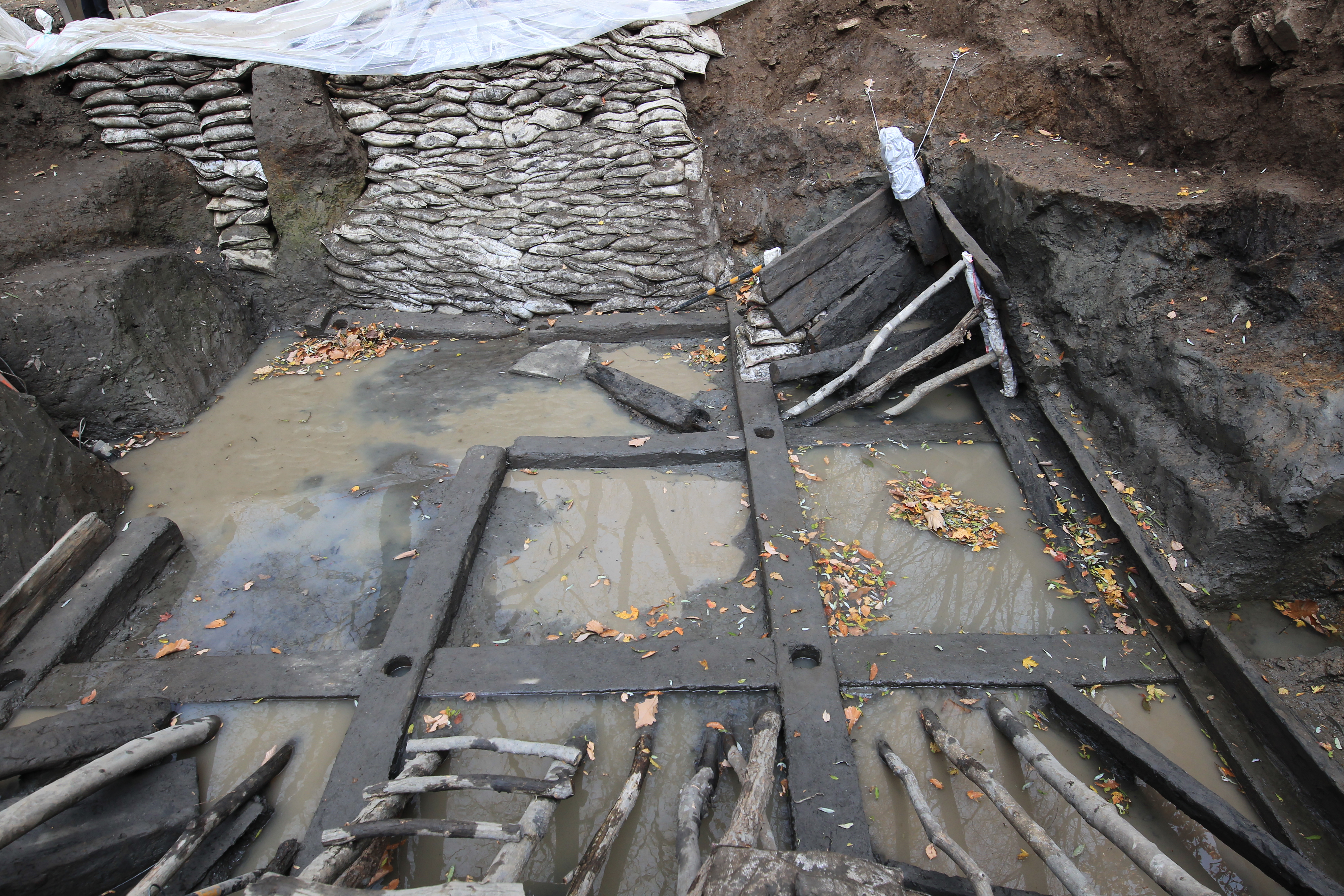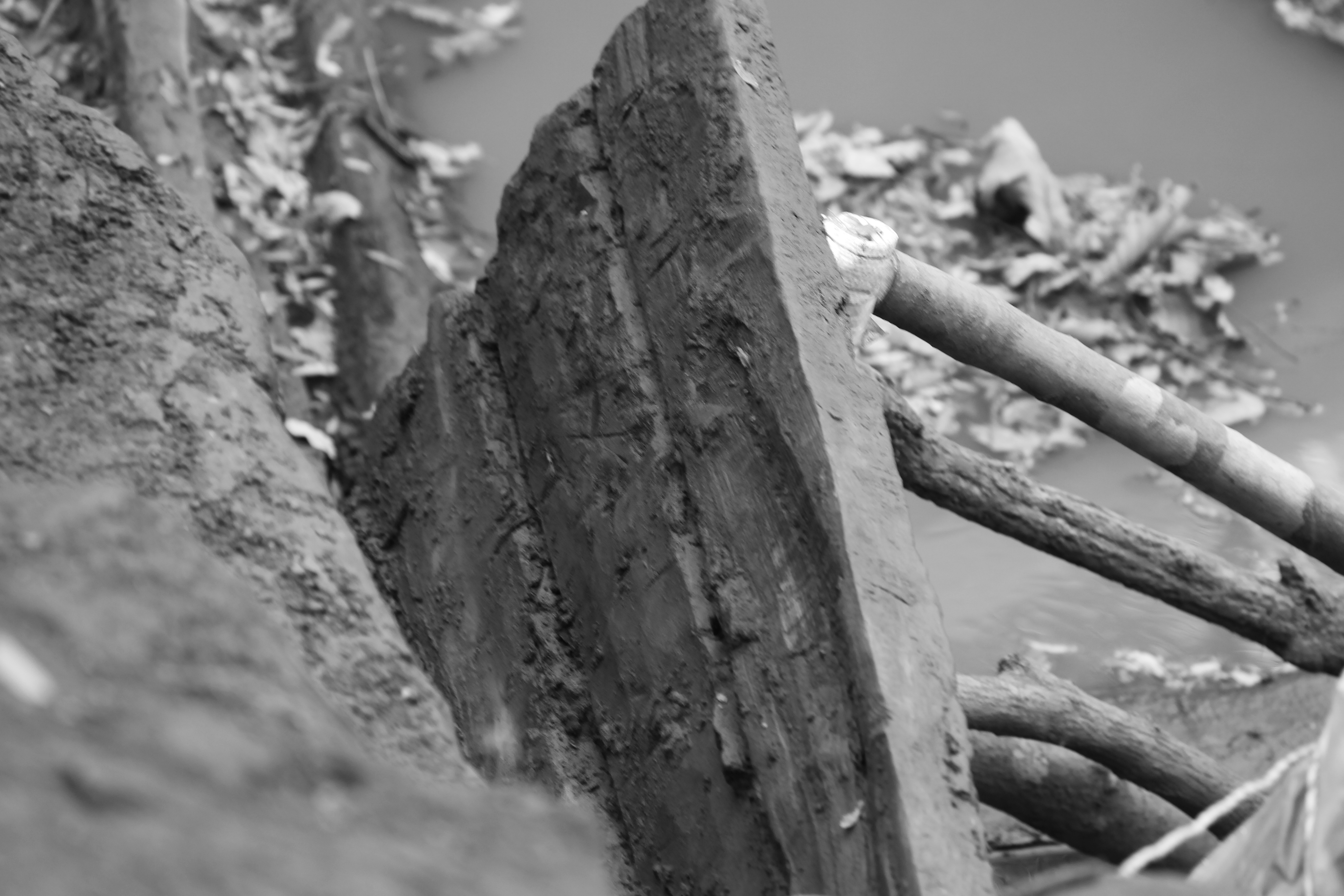
This underground wooden storage unit was excavated in 2017 at a three Kingdom period fortress called Wiryeseong Fortress in Mt. Seonggeosan, Cheonan, Chungcheongnam-do Province.
Before the excavation, there was a well inside the fortress called Yongsaem, literally "dragon well", where the storage facility was found.

This wooden facility is rectangular when viewed from the air, measuring 550 cm in width, 545 cm in length, and 180 cm in depth, which is the largest of the Baekje period (BC 18~AD 660) wooden structures found to date.
On the bottom of the well, relatively trimmed wood is intertwined in a grid without using nails.
Whilst boards were placed on all sides of the wall, at each intersection of these floor timbers, a hole about 12 cm in diameter was drilled and another wooden pillar was inserted. Traces of four pillars in the center and twelve pillars in the outside have been found.

Wiryeseong Fortress in Mt. Seonggeosan, Cheonan
천안 성거산 위례성 天安聖居山慰禮城
Address: San 81, Unyong-ri, BUk-myeon, Cheonan-si, Chungcheongnam-do
Period: Three Kingdoms Period
A mountain fortress located at the border between Unyong-ri, Buk-myeon and Hodang-ri, Ipjang-myeon, Cheonan-si
Wiryeseong Fortress is a peak-banding style fortress which encircles the summit area of the mountain (570m above sea level). Its circumference is 950m. It is estimated to be built for a defense purpose along with the Seongeosanseong Fortress and Sasanseong Fortress.

It is called ‘Jiksan Wiryeseong’ in the <Samguk sagi (History of the Three Kingdoms)> and <Samguk yusa (Memorabilia of the Three Kingdoms)>. The <Dongguk yeoji seungnam (Survey of the Geography of Korea)> has it that it was a 1,690-cheok fortress with a well. King Onjo as the founder of Baekje relocated the capital to Gwangju area of Gyeonggi Province in 5 B.C. (13th year of King Onjo).
The fortress has a shape encircling the summit of the mountain in one line. However, it is composed of the dual walls in some sections. The fortress walls are mixed with earthen walls and stone walls. The stone embankment was piled with natural stones, which its height is 4m. There were two gates in the east and west, which were almost destroyed.

The earth and stone-mixed fortress section was estimated to be established during the final period of Baekje or during the Unified Silla. The other section is identified to be established during the Goryeo and Joseon period.
The construction period of Wiryeseong Fortress is estimated to be during the early Baekje period in the position to assert the theory of Jiksan Wiryeseong, relating to the initial capital of Baekje. However, the construction period of Wiryeseong Fortress, which was solely based on the records of literature, is not clear because the actual investigation was not actually implemented.

천안 성거산 위례성 정상 바로 아래 용샘 발굴조사 중에 백제시대 목곽고木槨庫가 확인되기는 2017년. 정확한 발굴지점은 충청남도 천안시 서북구 입장면 호당리 산 45번지 일원.
천안시 의뢰로 충청남도역사문화연구원이 수행한 발굴조사에서 확인한 이 목곽고는 백제시대에 등장한 이래 통일신라를 거쳐 고려, 조선시대에 죽 사용되면서 나중에는 석축으로 변모한 것으로 드러났다.
평면 사각형인 목곽고는 가로 550㎝, 세로 545㎝, 깊이 약 180㎝로, 대전 월평동산성 목곽고(520×521㎝)를 필두로 하는 종래 알려진 백제시대 목곽고보다 규모가 컸다.

우물 바닥에다가는 못을 사용하지 않고 3×3칸 규모 격자 형태로 목재들을 연결해 설치하고, 그들이 교차하는 지점에는 지름 12㎝가량 되는 구멍을 뚫고 그에다가 다른 기둥을 끼워 세웠으니, 이런 기둥 흔적이 중앙에 4개, 외곽에 12개가 확인된다.
성거산 위례성은 삼국유사에서 천안 지역을 온조가 정착해 백제를 건국했다는 위례성으로 지목했다는 점에서 그 연관으로 주목받는다. 다만, 이곳이 위례성이라 보는 시각은 향토사학자들을 제외하고는 거의 없는 실정이다.
***
이 발굴현장을 내가 찾은 때는 2017년 11월 18일. 그날 날씨가 아주 쌀쌀했다고 기억하거니와, 비교적 험준한 능선을 따라 발굴현장으로 한창 올라가는 그 순간에 경주에서 대지진이 발생했다는 소식이 전해졌다.
당시 나는 해고된지 2년만에 복직하고 얼마가 지난 뒤였으니, 전국부에서 하릴 없이 월급 축만 내고 있었으니 참으로 행복한 나날을 보내는 중이었으니, 그때야 기사에 대한 부담도 없었으니 맘대로 구경만 했다.
'문화재현장' 카테고리의 다른 글
| 익산 쌍릉 益山雙陵 (0) | 2020.06.25 |
|---|---|
| Songgwangsa Temple 순천 송광사 (0) | 2020.06.25 |
| Viking House in Dublin, 바이킹의 집 (2) | 2020.06.24 |
| 장성 삼서 잔디밭 우뚝한 금성나씨 삼강문 (4) | 2020.06.24 |
| 4,500 year old LURGAN LOGBOAT, DUGOUT CANOE (0) | 2020.06.23 |




댓글